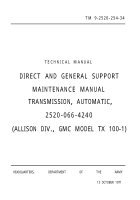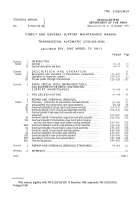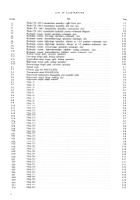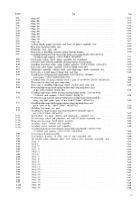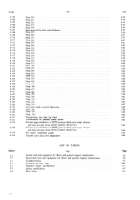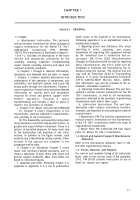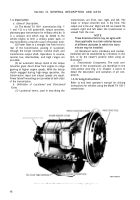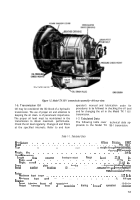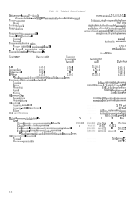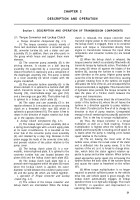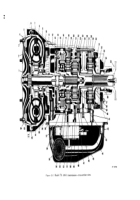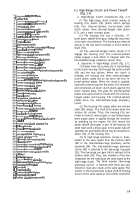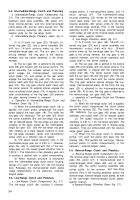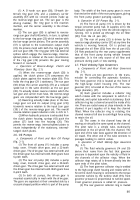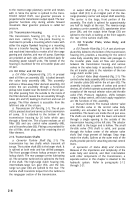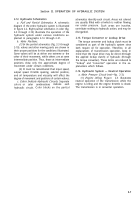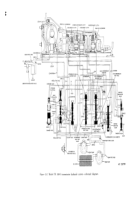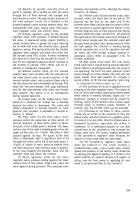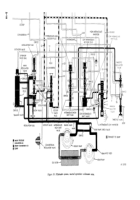TM-9-2520-254-34 - Page 10 of 126
CHAPTER 2
DESCRIPTION AND OPERATION
Section I. DESCRIPTION AND OPERATION OF TRANSMISSION COMPONENTS
2-1. Torque Converter and Lockup Clutch
a. Torque Converter Components
(fig. 2-1).
(1) The torque converter consists mainly of
three cast aluminum elements: a converter pump
(8), converter turbine (6), and a stator and cam
assembly (7). In addition, there are other parts in
the group which house and support these main
elements.
(2) The converter pump assembly (8) is the
driving element. It rotates on a ball bearing
assembly (9) supported by a converter ground
sleeve (10) which is stationary and a component of
the diaphragm assembly (12). The pump is bolted
to a cover assembly (4) which rotates with the
engine crankshaft.
(3) The converter turbine assembly (6)
is the
driven element. It is splined to a turbine shaft (59)
which transmits torque to a high-range clutch
housing (16), intermediate-range sun gear (53),
and a low-range sun gear (46). The turbine hub (2)
is splined to a lockup clutch plate (5).
(4) The stator and cam assembly (7) is the
reaction element. It is mounted on an over-running
clutch on a freewheel roller race (63) which is
splined to a ground sleeve (10). The stator is free to
rotate in the direction of engine rotation but locks
up in the opposite direction.
b. lockup Clutch Components
(fig. 2-1).
(1) The lockup clutch piston assembly (64) is
a spring steel diaphragm with a clutch apply plate
at its outer circumference. It is mounted on the
inner hub of the converter pump cover assembly
(4). and retained by a snap ring. Recesses in the
piston engage the heads of the converter drive bolts,
and prevent rotation of the piston relative to the
pump cover.
(2) The lockup clutch plate (5) is a non-
metallic, internal-splined plate. It is splined to the
converter turbine hub and located between the
piston (64) and the lockup clutch back plate (62).
(3) The lockup clutch back plate (62) is a
pressed steel ring against which the plate (5) reacts
when the lockup clutch is applied. Its outer
diameter is held between the converter pump cover
(4) and tbe pump (8) which are bolted together.
c. operation of Torque Converter and Lockup
Clutch
(fig. 2-1).
(1) The actions of the torque converter and
lockup clutch are interrelated. When the lockup
clutch is released, the torque converter must
transmit engine power to the transmission. When
the lockup clutch is engaged, there is no converter
action and torque is transmitted directly from
engine to transmission because the input drive
components and converter turbine (6) are locked
together.
(2) When the lockup clutch is released, the
torque converter (which is constantly filled with oil)
transmits torque by hydraulic action. The blades of
the pump (8) throw oil against the blades of the
turbine (6), causing the turbine to rotate in the
same direction as the pump. Higher pump speeds
cause the oil to be thrown with more force, causing
a greater rotating force in the turbine. At engine
idle speed, the force of the oil, and consequently the
torque transmitted, is negligible. This characteristic
of hydraulic drive permits the torque converter to
take the place of a friction clutch between the
engine and transmission.
(3) The turbine vanes direct the oil toward the
center of the turbine (6), where the oil leaves the
turbine in a direction opposite to pump rotation.
The stator (7) redirects the flow of oil to change its
direction to that of pump rotation. Unexpended
energy in the oil reentering the pump (8) assists the
pump. This is the key to torque multiplication.
(4) Thus, the torque converter is a torque
multiplier as well as a fluid coupling. Torque
multiplication is highest when the turbine (6) is
stalled and the pump (8) is rotating at full speed. It
is lowest when the pump is rotating at its lowest
speed relative to the turbine.
(5) The oil, leaving the inner ends of the
turbine vanes, strikes the curved vanes of the stator
and is deflected into the pump vanes. It is the
reaction of the oil, as it is forced to change direc-
tion, which locks the stator against rotation op-
posite to pump and turbine rotation. When turbine
speed approaches pump speed, the oil leaving the
turbine strikes the back sides of the turbine vanes
and causes the stator to freewheel on the rollers
(61).
(6) When torque multiplication is no longer
required to provide sufficient power to the vehicle
drive line and vehicle speed is great enough, the
lockup clutch automatically engages. In lockup
operation there is no hydraulic slippage. The result
is economy
in operation and improvement in
operating characteristics.
2-1
Back to Top

